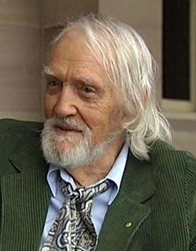

David Boyd was born in Melbourne in 1924. He was the fourth child of artists Merric and Doris Boyd’s five children. The Boyd family has a long tradition of artistic and musical talent and has produced a number of Australian cultural figures, including Arthur Merric Boyd, Guy Martin Boyd and Merric Boyd. Together with his four siblings, Boyd spent his childhood at the family farm and pottery, Open Country, in Murrumbeena, Victoria. *
As a young man, the artist studied at the Melba Memorial Conservatorium of Music in Melbourne until he was conscripted to fight in the army. However, being a pacifist like his brothers, he refused military service and risked his health in hunger strikes in order to avoid bearing arms.** From 1944 to 1946, he studied fine arts at the National Gallery School and began working with ceramics.
After WWII, David and his brother Guy moved to Sydney where they established Martin Boyd Pottery, producing high quality ceramics. In 1949, David married Hermia Lloyd-Jones, daughter of graphic artist Herman (Jonah) and Erica Lloyd-Jones, and together they set up a pottery in their shed in Elizabeth Bay. They moved to London in 1951, where their joint pottery ventures attracted significant media attention and they were hailed as a ‘golden couple’.** On their return to Melbourne in 1954, they introduced a new wave of Australian pottery, devising new glazes and methods of using the wheel to shape sculptural figures. Their three daughters also became potters.
Although initially acclaimed as a potter and ceramic sculptor, Boyd began his career as a painter in 1957 with a series of paintings on Australian explorers and aboriginal Tasmanians, depicting aborigines as gentle, frightened people not wanting to be deprived of their homeland. This was not a popular concept at the time and provoked a storm of controversy. He became one of the seven members of Bernard Smith’s ‘Antipodean’ group of figurative artists, joining his elder brother Arthur Boyd, Charles Blackman, John Brack, Robert Dickerson, John Perceval and Clifton Pugh.** In 1960, Boyd became Chairman of the Contemporary Arts Society of Australia and Elected Councillor of the Museum of Modern Art of Australia.
After winning an Italian Art Scholarship from the Contemporary Art Society of Australia in 1961, the Boyd family moved to Rome and Boyd worked and travelled throughout Europe and in the UK from 1962 to 1971, winning significant international recognition. On his return to Sydney in 1971, Boyd produced some of his most delightful work, combining angels, aborigines and children dancing through his beloved bush. Noisy aeroplanes, represented by cockatoos, became the subject of some of his later paintings. * For the next 20 years, Boyd travelled and exhibited overseas and at home to world acclaim. Boyd was artist-in-residence at the School of Law, Macquarie University, NSW from 1993 to 1996.
A buoyant, witty man, known for his informality, friendliness and generosity, David Boyd maintained his quiet but strenuous daily routine in the studio where he worked in “controlled chaos”.** He stopped painting in 2005, after breaking a hip, but continued to make etchings in collaboration with James Whitington. In June 2008, Boyd was awarded an OAM for his services to art as a painter and an innovator of design and technique in pottery and ceramic sculpture. ** In 2009, he moved to Braidwood, where he was cared for by his daughter Lucinda. Boyd died on 10 November 2011 in Sydney, Australia at age 87.
Boyd’s first joint exhibition of his paintings was as part of the Antipodean group, exhibiting his Truganini series in Melbourne in 1959. His first solo exhibition of his paintings in London was held at the Whitechapel Art Gallery in 1961. Boyd was invited by the Commonwealth Institute of Art, London, to hold a retrospective of paintings at their Art Gallery in 1969. An exhibition of his life’s work, David Boyd: his life, his work, his family, was held after his death in 2012.
Boyd is best known for his fluid landscape paintings which depicted themes from colonial history. His colourful works can be categorised by their textured brushstrokes and wavy, psychedelic imagery. As a humanist, his paintings are full of social comment, showing that there is still a place in Australian art for a moral painter.
In a September 2004 art review, Alex McDonald of State of the Arts magazine commented that David Boyd’s work was “ahead of his time in addressing the mistreatment of Indigenous people in Australia” and explained how “his frosty reception from Australian critics and dealers may have something to do with his choice of subject matter”: the “legal system, race relations and religion” were are “not exactly popular issues” and were simply “not up for debate in the late 1950s”.***
Several major series, including the Trial, the Tasmanian Aborigines, the Wanderer and the Exiles, demonstrate his highly dramatic style with the juxtaposition of innocence and evil. He once said: “I often think of myself as being a spiritual anarchist” and his work has been described as “a massive human protest against inhumanity”. **
Boyd’s works are widely held in Collections throughout Australia, including the Art Gallery of New South Wales, the National Gallery of Victoria, the Queensland Art Gallery, the Art Gallery of Western Australia, the Art Gallery of South Australia and many other state and regional galleries, corporate, university and significant private Collections throughout Australia and in the UK.
* Biography of David Boyd, Joanna Mendelssohn and Eva Breuer, Design & Art Australia Online, updated 2012. ** Figurative artist stepped out from his brother’s shadow, Brenda Niall with Lucinda Boyd, Sydney Morning Herald, 12 December 2011 *** Controversial Australian Artist David Boyd dies, Artlyst, 11 November 2011.
Copyright © 2007 Abstract Australis. All rights reserved. Click here to view copyright statement